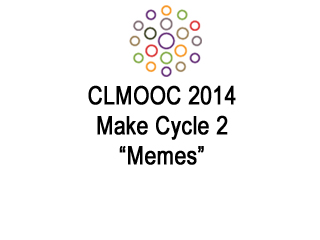For Make Cycle #2 of CLMOOC 2014, we are exploring memes.
So what’s a meme? Evolutionary biologist Richard Dawkins, who coined the term, defined a meme as a bit of culture that gets propagated. It’s basically culture’s version of what genes are to biology. Conceptually, then, anything that spreads and evolves widely in a culture is a meme; in the 60s, the peace sign was a meme; fashion trends are memes; popular quotes from movies are memes. When most people think of memes, a specific kind of captioned image, like the well-known LOLcats and their canine counterparts, the Fail Dog, come to mind. In common internet parlance, “meme” refers to those viral images and videos that spread like wildfire through social media spaces.
There are hundreds of different image-based memes floating around, and they seem at first glance to be quite simple. These memes actually convey a lot of information in a very compressed form, and often require lots of inference to understand. Someone who had seen neither Willy Wonka and the Chocolate Factory nor The Princess Bride would likely be baffled by a meme like the meme pictured here.
What’s interesting to us about these kinds of memes is that they have become a kind of shorthand for certain ideas, while also having really specific genre requirements. For instance, the Gene Wilder image above, without any text added, could be interpreted in any number of ways. He looks happy enough. But within the meme-making community of practice, this specific image of Willy Wonka has been given only two possible emotional reads: either condescending or creepy. It’s condescending Wonka in the meme above, obviously. We’ll let you investigate, if you want, the creepy side of the Wonka meme, but we mention it because not all memes are going to be school-appropriate, and knowing your meme is always a good idea.





